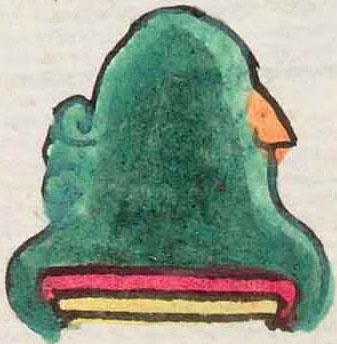Tlayacac (Mdz24v)
This compound sign for the place name Tlayacac has two principal visual components, a hill or mountain (tepetl) and a nose (yacatl) coming our of the right slope. The mountain, with its typical bell shape, is painted with two tones of green, and it has yellow and red horizontal stripes at its base. The locative suffix -c has combined with yaca-, to draw attention to the mountain's peak. Today, there is a Tlayecac and a Tlayacapan in the state of Morelos.
Stephanie Wood
The nose does not have a semantic value meant to convey something about the human body, other than the nose has a point and so can the mountain. This glyph, incidentally, is very much like others we have for Tepeyacac. The Tla- is an indefinite prefix. Here, too, a difference is that the mountain is a semantic complement and does not appear as part of the name. It just implies a mountain peak.
Stephanie Wood
tlayacac.puo
Tlayacac, pueblo
Stephanie Wood
c. 1541, but by 1553 at the latest
Stephanie Wood
hills, mountains, peaks, picos, montañas, cerros, narices, noses, nombres de lugares

"At the Point" [Gordon Whittaker, Deciphering Aztec Hieroglyphs, 2021, 106]
.YACA.-MOUNTAIN
Codex Mendoza, folio 24 verso, https://digital.bodleian.ox.ac.uk/objects/2fea788e-2aa2-4f08-b6d9-648c00..., image 59 of 188.
The Bodleian Libraries, University of Oxford, hold the original manuscript, the MS. Arch. Selden. A. 1. This image is published here under the UK Creative Commons, “Attribution-NonCommercial-ShareAlike 3.0 License” (CC-BY-NC-SA 3.0).



